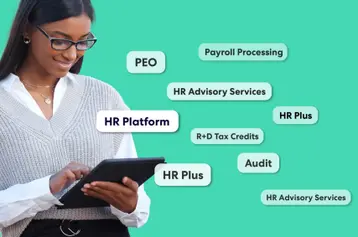What’s the Difference Between a PEO and ASO — and Why it Matters

Table of contents
- 1.What is an ASO?
- 2.How does an ASO work?
- 3.What is a PEO?
- 4.How does a PEO work?
- 5.Which tasks does a PEO handle on an employer’s behalf?
- 6.What types of businesses are suited to using a PEO model?
- 7.Frequently Asked Questions (FAQs)
- 8.What are the benefits of using a PEO for compliance?
At TriNet we provide HR services to over 16,000 small and medium size businesses (SMBs) across the U.S. and across several different industries including technology, life sciences, financial services, professional services, nonprofit, retail and more. Because we work with so many SMBs we understand their complex HR needs and their day-to-day HR challenges. And every now and then, we get asked about the difference between PEOs and ASOs. It is a great question because the difference is often misunderstood. Continue reading to learn the difference.
What is an ASO?
The term “ASO,” on the other hand, stands for Administrative Services Organization. The most important difference between an ASO and a PEO is that the service provided through an ASO does not establish a co-employer relationship. For example, an ASO does not process payroll and remit and report payroll taxes under its own FEIN, nor can it be the sponsor of any health and welfare benefits offered to its customers’ employees.
How does an ASO work?
An ASO oversees the day-to-day administrative aspects of managing a company’s HR functions. While an ASO does not sponsor employee benefit programs or workers’ compensation coverage, an ASO may assist in arranging coverage. The client company remains the sole sponsor of all benefits and insurance coverage when working with an ASO and maintains all fiduciary responsibilities.
What is a PEO?
The term “PEO” stands for Professional Employer Organization. PEOs provide small and medium size businesses with a bundled offering of HR services, including payroll, health and welfare benefits, workers’ compensation, and risk management services.
How does a PEO work?
A PEO offers its services as a “co-employer” or through a “co-employment” relationship. Co-employment refers to the fact that the PEO allocates, with each of its clients, employer responsibilities relating to the employees the client brings into its arrangement with the PEO, which are usually referred to as worksite employees. Typically, the PEO and client responsibilities are expressly described in a service agreement between the PEO and the client.
Through this arrangement the client maintains its own, separate employment relationship with its worksite employees, just as it would without a PEO. As the co-employer of the worksite employees, the PEO is able to provide worksite employees with access to HR services, products and benefits not typically available to SMB employees.
A common misconception is that a PEO client loses control of its workforce through co-employment. On the contrary, companies working with PEOs retain complete control over their workforces and their day-to-day operations. PEO clients continue to make their own decisions about recruiting, hiring, discipline, termination of employment, day-to-day scheduling, pay, promotions, demotions, supervision, performance management, reviews, workplace safety, company culture … and the list goes on. Moreover, in making such decisions and acting on them, PEO clients can use and benefit from their PEO’s HR expertise, offerings, systems and processes.
Furthermore, certain PEOs are “Certified” by the IRS or accredited by independent agencies such as the Employer Services Assurance Corporation (ESAC). Such certification and accreditations require additional disclosures, certifications, and requirements of the PEO, and can involve the PEO posting or obtaining additional surety bonds covering their services.
Which tasks does a PEO handle on an employer’s behalf?
The exact responsibilities that a PEO takes on will depend on the PEO and the specific allocation of responsibilities in the service agreement between the PEO and the client. Typically, a PEO will take responsibility for processing payroll based on input from clients, paying and reporting wages to worksite employees in the name of the PEO and under its federal employer identification number (FEIN), remitting and reporting payroll taxes, sponsoring large group employer health and welfare benefits, obtaining various insurance policies for risk management purposes, assisting with the handling of various claims from worksite employees, and assisting with HR best practices and compliance. Other services may be provided as well.
What types of businesses are suited to using a PEO model?
Small to medium businesses are best suited to the PEO model because PEOs usually provide HR expertise and compliance assistance, large group employer health and welfare benefits, payroll services, risk mitigation programs, and technology to make administering HR easier – necessities that SMBs would otherwise have to go to multiple service providers to obtain. Plus, all of this translates to more time for SMBs to focus on their business, greater ability to attract talent, and less stress over HR and HR risks.
Frequently Asked Questions (FAQs)
What are the benefits of using a PEO for compliance?
Using a professional employer organization (PEO) offers significant compliance advantages for small and mid-sized businesses. Because the PEO becomes the employer of record in a co-employment relationship, it takes on responsibility for payroll tax filings, workers’ compensation administration, and employment law adherence—reducing your exposure to regulatory risk.
Additionally, through pooled scale and specialized HR expertise, a PEO can help you stay on top of evolving federal, state, and local labor laws and implement standardized policies, training, and documentation. This allows your team to focus on core operations while gaining a partner that actively monitors and manages compliance obligations.
This communication is for informational purposes only; it is not legal, tax or accounting advice; and is not an offer to sell, buy or procure insurance.
This post may contain hyperlinks to websites operated by parties other than TriNet. Such hyperlinks are provided for reference only. TriNet does not control such websites and is not responsible for their content. Inclusion of such hyperlinks on TriNet.com does not necessarily imply any endorsement of the material on such websites or association with their operators
TriNet Team
Table of contents
- 1.What is an ASO?
- 2.How does an ASO work?
- 3.What is a PEO?
- 4.How does a PEO work?
- 5.Which tasks does a PEO handle on an employer’s behalf?
- 6.What types of businesses are suited to using a PEO model?
- 7.Frequently Asked Questions (FAQs)
- 8.What are the benefits of using a PEO for compliance?






